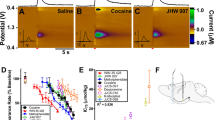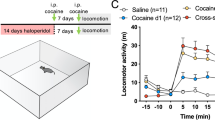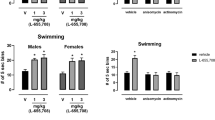Abstract
SUPERSENSITIVITY following the interruption of synaptic transmission within the dopamine (DA) system has now been established by behavioural1–3, biochemical4–6 and electrophysiological7,8 evidence. Following production of lesions which interupt DA input1, or treatment with pharmacological agents which chronically disrupt dopaminergic transmission3,9,10, an increase in the sensitivity of postsynaptic (receiving input from dopaminergic neurones) responses of cells to DA and DA agonists has been observed. However, several studies have suggested that in vivo, presynaptic DA or ‘autoreceptors’ (that is, dopaminoceptive sites on DA-containing cells) may have an important physiological role in the modulation of DA synthesis and release11–13. Thus, alterations in the sensitivity of presynaptic cells may have profound effects on the availability of the neurotransmitter. To date, only one study has attempted to investigate whether dopaminergic supersensitivity could be a presynaptic, as well as a postsynaptic, phenomenon; following long-term treatment of rats with a phenothiazine, an increase in the sensitivity of DA-containing neurones in the substantia nigra to the DA agonist, apomorphine, has been observed14. We present here electrophysiological evidence for increased presynaptic sensitivity following chronic haloperidol treatment, as measured by both the direct iontophoretic application of DA and the systemic administration of apomorphine to DA-containing cells in the zona compacta region of the substantia nigra. In addition, it has been found recently that rats treated concurrently with lithium and haloperidol fail to develop postsynaptic supersensitivity, as measured by alterations in behavioural sensitivity15,16 and DA-receptor binding16. Several groups have theorised that alterations in catecholamine receptor sensitivity may be a factor in the aetiology of affective disorders, especially manic-depressive illness17,18. As lithium therapy has been shown to be effective in preventing recurrent episodes of mania and depression in manic-depressive illness19, it is of interest to determine whether, at the level of individual DA neurones in the CNS, chronic lithium treatment could also affect the development of presynaptic supersensitivity. We provide here electrophysiological evidence for the blockade of presynaptic supersensitivity development following chronic lithium treatment.
This is a preview of subscription content, access via your institution
Access options
Subscribe to this journal
Receive 51 print issues and online access
$199.00 per year
only $3.90 per issue
Buy this article
- Purchase on Springer Link
- Instant access to full article PDF
Prices may be subject to local taxes which are calculated during checkout
Similar content being viewed by others
References
Ungerstedt, U. Acta physiol. scand. suppl. 367, 1–122 (1971).
Klawans, H. L. & Rubovitz, H. J. neurol. Transm. 33, 235 (1974).
Tarsy, D. & Baldessarini, R. J. Neuropharmacology 13, 927–940 (1974).
Gianutsos, G., Hynes, M. D. & Lal, H. Biochem. Pharmac. 24, 581–582 (1975).
Gianutsos, G. & Moore, K. Life Sci. 20, 1585–1592 (1977).
Burt, D., Creese, I. & Snyder, S. H. Science 196, 326–328 (1977).
Siggins, G. R., Hoffer, B. J. & Ungerstedt, U. Life Sci. 15, 779–792 (1974).
Yarbrough, G. Eur. J. Pharmac. 31, 367–369 (1975).
Sayers, A. C., Bürki, H. R., Ruch, W. & Asper, H. Psychopharmacologia 41, 97–104 (1975).
Christensen, A. V., Fjalland, B. & Møller-Nielsen, I. Psychopharmacologia 48, 1–6 (1976).
Iversen, L., Rogawski, M. & Miller, R. Molec. Pharmac. 12, 251–263 (1976).
Walters, J. & Roth, R. Naunyn-Schmiedebergs Arch. exp. Path. Pharmac. 296, 5–14 (1976).
Westfall, T., Besson, M-J., Giorguieff, M-F. & Glowinski, J. Naunyn-Schmiedebergs Arch. exp. Path. Pharmac. 292, 279–287 (1976).
Nowycky, M. & Roth, R. Naunyn-Schmiedebergs Arch. Pharmac. 300, 247–254 (1977).
Klawans, H. L., Weiner, W. J. & Nausieda, P. A. Prog. Neuropsychopharmac. 1, 53–60 (1977).
Pert, A., Rosenblatt, J., Sivit, C., Pert, C. B. & Bunney, W. E. Jr, Science (in the press).
Ashcroft, G. W. et al. Lancet ii, 573–577 (1972).
Bunney, W. E., Jr, Post, R. M., Andersen, A. E. & Kopanda, R. T. Commun. Psychopharmac. 1, 393–406 (1977).
Schou, M. Neurosci. Res. Prog. Bull. 14, 117–131 (1976).
Thomsen, K. Acta pharmac. Tox. 33, 92–102 (1973).
Bunney, B. S., Aghajanian, G. K. & Roth, R. H. Nature 245, 123–125 (1973).
Segal, M. Nature 250, 70–73 (1974).
Trendelenburg, U. Pharmac. Rev. 15, 225–276 (1963).
Bunney, B. S., Walters, J., Roth, R. & Aghajanian, G. J. Pharmac. exp. Ther. 185, 560–571 (1973).
Glowinski, J. in Biology of the Major Psychoses (ed. Freedman, D.) 233–276 (Raven, New York, 1975).
Haigler, H. & Aghajanian, G. J. Pharmac. exp. Ther. 188, 688–699 (1974).
Author information
Authors and Affiliations
Rights and permissions
About this article
Cite this article
GALLAGER, D., PERT, A. & BUNNEY, W. Haloperidol-induced presynaptic dopamine supersensitivity is blocked by chronic lithium. Nature 273, 309–312 (1978). https://doi.org/10.1038/273309a0
Received:
Accepted:
Issue Date:
DOI: https://doi.org/10.1038/273309a0
This article is cited by
-
Mood and behavior regulation: interaction of lithium and dopaminergic system
Naunyn-Schmiedeberg's Archives of Pharmacology (2023)
-
Chronic Lithium Chloride Administration to Unanesthetized Rats Attenuates Brain Dopamine D2-Like Receptor-Initiated Signaling Via Arachidonic Acid
Neuropsychopharmacology (2005)
-
Effect of chronic lithium treatment with or without haloperidol on number and sizes of neurons in rat neocortex
Psychopharmacology (1994)
Comments
By submitting a comment you agree to abide by our Terms and Community Guidelines. If you find something abusive or that does not comply with our terms or guidelines please flag it as inappropriate.



